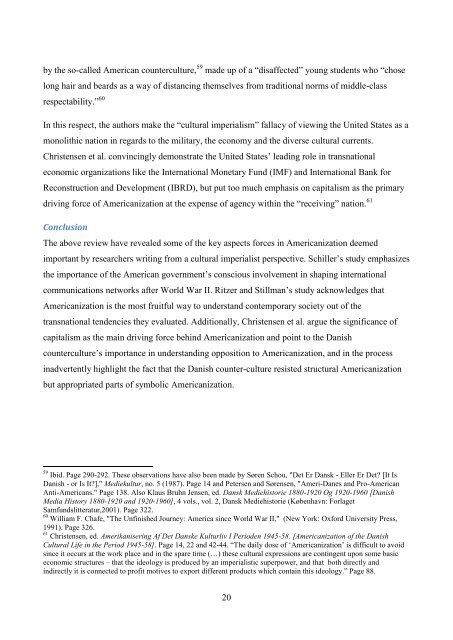The Jeremiad Over Journalism
The Jeremiad Over Journalism
The Jeremiad Over Journalism
You also want an ePaper? Increase the reach of your titles
YUMPU automatically turns print PDFs into web optimized ePapers that Google loves.
y the so-called American counterculture, 59 made up of a ―disaffected‖ young students who ―chose<br />
long hair and beards as a way of distancing themselves from traditional norms of middle-class<br />
respectability.‖ 60<br />
In this respect, the authors make the ―cultural imperialism‖ fallacy of viewing the United States as a<br />
monolithic nation in regards to the military, the economy and the diverse cultural currents.<br />
Christensen et al. convincingly demonstrate the United States‘ leading role in transnational<br />
economic organizations like the International Monetary Fund (IMF) and International Bank for<br />
Reconstruction and Development (IBRD), but put too much emphasis on capitalism as the primary<br />
driving force of Americanization at the expense of agency within the ―receiving‖ nation. 61<br />
Conclusion<br />
<strong>The</strong> above review have revealed some of the key aspects forces in Americanization deemed<br />
important by researchers writing from a cultural imperialist perspective. Schiller‘s study emphasizes<br />
the importance of the American government‘s conscious involvement in shaping international<br />
communications networks after World War II. Ritzer and Stillman‘s study acknowledges that<br />
Americanization is the most fruitful way to understand contemporary society out of the<br />
transnational tendencies they evaluated. Additionally, Christensen et al. argue the significance of<br />
capitalism as the main driving force behind Americanization and point to the Danish<br />
counterculture‘s importance in understanding opposition to Americanization, and in the process<br />
inadvertently highlight the fact that the Danish counter-culture resisted structural Americanization<br />
but appropriated parts of symbolic Americanization.<br />
59<br />
Ibid. Page 290-292. <strong>The</strong>se observations have also been made by Søren Schou, "Det Er Dansk - Eller Er Det? [It Is<br />
Danish - or Is It?]," Mediekultur, no. 5 (1987). Page 14 and Petersen and Sørensen, "Ameri-Danes and Pro-American<br />
Anti-Americans." Page 138. Also Klaus Bruhn Jensen, ed. Dansk Mediehistorie 1880-1920 Og 1920-1960 [Danish<br />
Media History 1880-1920 and 1920-1960], 4 vols., vol. 2, Dansk Mediehistorie (København: Forlaget<br />
Samfundslitteratur,2001). Page 322.<br />
60<br />
William F. Chafe, "<strong>The</strong> Unfinished Journey: America since World War II," (New York: Oxford University Press,<br />
1991). Page 326.<br />
61<br />
Christensen, ed. Amerikanisering Af Det Danske Kulturliv I Perioden 1945-58. [Americanization of the Danish<br />
Cultural Life in the Period 1945-58]. Page 14, 22 and 42-44. ―<strong>The</strong> daily dose of ‗Americanization‘ is difficult to avoid<br />
since it occurs at the work place and in the spare time (…) these cultural expressions are contingent upon some basic<br />
economic structures – that the ideology is produced by an imperialistic superpower, and that both directly and<br />
indirectly it is connected to profit motives to export different products which contain this ideology.‖ Page 88.<br />
20
















